人教版选修七Unit3Underthesea
- 格式:pptx
- 大小:5.05 MB
- 文档页数:30
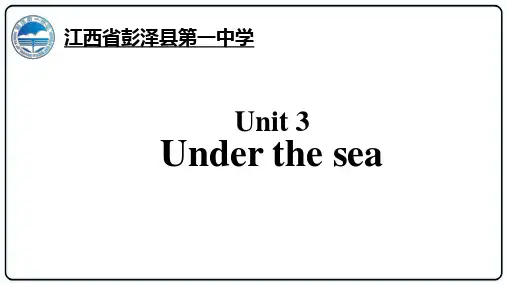
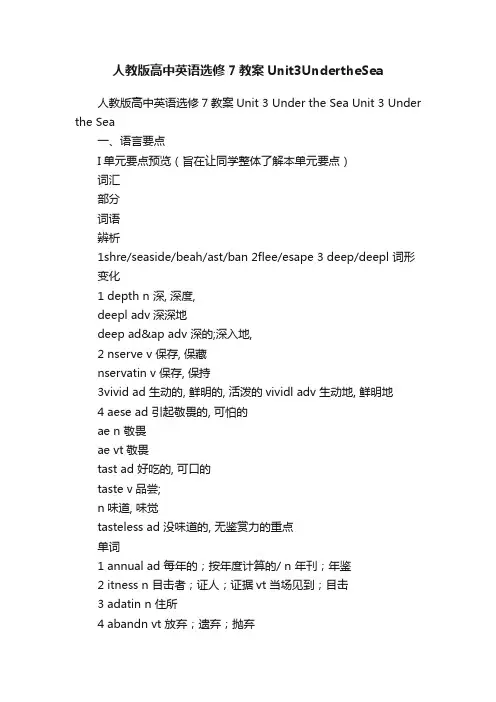
人教版高中英语选修7教案Unit3UndertheSea人教版高中英语选修7教案Unit 3 Under the Sea Unit 3 Under the Sea一、语言要点I单元要点预览(旨在让同学整体了解本单元要点)词汇部分词语辨析1shre/seaside/beah/ast/ban 2flee/esape 3 deep/deepl 词形变化1 depth n 深, 深度,deepl adv深深地deep ad&ap adv 深的;深入地,2 nserve v 保存, 保藏nservatin v 保存, 保持3vivid ad 生动的, 鲜明的, 活泼的vividl adv 生动地, 鲜明地4 aese ad 引起敬畏的, 可怕的ae n 敬畏ae vt敬畏tast ad 好吃的, 可口的taste v品尝;n味道, 味觉tasteless ad 没味道的, 无鉴赏力的重点单词1 annual ad 每年的;按年度计算的/ n 年刊;年鉴2 itness n 目击者;证人;证据vt 当场见到;目击3 adatin n 住所4 abandn vt 放弃;遗弃;抛弃reflet vt 映射;反射vi &ap vt 思考6 aare ad 意识到的;知道的7 sare vt 恐吓vi 受惊吓重点词组srt ut整理;挑出help ut 帮助……(摆脱困难或危难);协助;使……脱离困境thr neself ut f 跃出upside dn上下翻转过重点句型1 It as a tie h en the iller hales, r “illers” as the ere then alled, helped the halers ath the baleen hales that ere n their annual igratin2 I had alread heard that Gerge didn’t lie being ept aiting, s even thugh Ididn’t have the right lthes n, raed after hi3 I’sittin g in the ar night air ith a ld drin in hand and refleting n the da-a da f pure agi!重点语法被动语态(II)(见语法专题)II 词语辨析(旨在提供完形填空所需材料)1) shre/seaside/beah/ast/ban n海边,海岸【解释】shre 指海岸,湖岸,也指近海的一带。
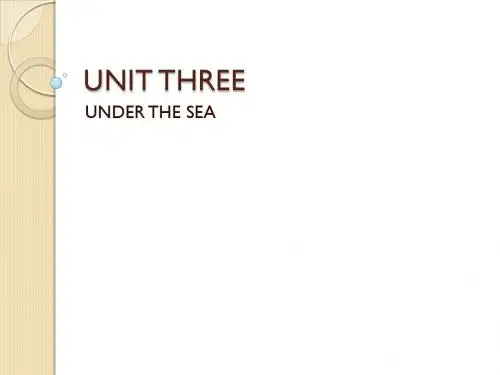
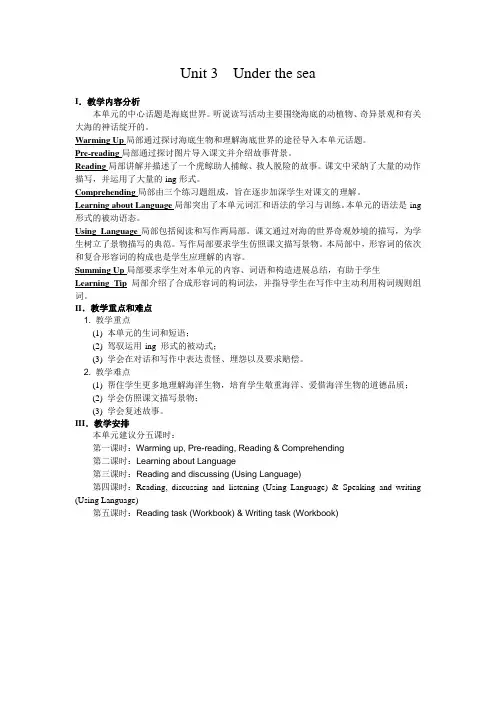
Unit 3 Under the seaI.教学内容分析本单元的中心话题是海底世界。
听说读写活动主要围绕海底的动植物、奇异景观和有关大海的神话绽开的。
Warming Up局部通过探讨海底生物和理解海底世界的途径导入本单元话题。
Pre-reading局部通过探讨图片导入课文并介绍故事背景。
Reading局部讲解并描述了一个虎鲸助人捕鲸、救人脱险的故事。
课文中采纳了大量的动作描写,并运用了大量的-ing形式。
Comprehending局部由三个练习题组成,旨在逐步加深学生对课文的理解。
Learning about Language局部突出了本单元词汇和语法的学习与训练。
本单元的语法是-ing 形式的被动语态。
Using Language局部包括阅读和写作两局部。
课文通过对海的世界奇观妙境的描写,为学生树立了景物描写的典范。
写作局部要求学生仿照课文描写景物。
本局部中,形容词的依次和复合形容词的构成也是学生应理解的内容。
Summing Up局部要求学生对本单元的内容、词语和构造进展总结,有助于学生Learning Tip 局部介绍了合成形容词的构词法,并指导学生在写作中主动利用构词规则组词。
II.教学重点和难点1. 教学重点(1) 本单元的生词和短语;(2) 驾驭运用-ing 形式的被动式;(3) 学会在对话和写作中表达责怪、埋怨以及要求赔偿。
2. 教学难点(1) 帮住学生更多地理解海洋生物,培育学生敬重海洋、爱惜海洋生物的道德品质;(2) 学会仿照课文描写景物;(3) 学会复述故事。
III.教学安排本单元建议分五课时:第一课时:Warming up, Pre-reading, Reading & Comprehending第二课时:Learning about Language第三课时:Reading and discussing (Using Language)第四课时:Reading, discussing and listening (Using Language) & Speaking and writing (Using Language)第五课时:Reading task (Workbook) & Writing task (Workbook)Period 1 Warming up, Pre-reading, Reading & Comprehending Teaching Goals:1. To arouse Ss’ interest in animals and plants living under the sea.2. To develop Ss’ reading ability.3. To appreciate how the writer describes movements.Teaching Procedures:Step 1. Leading-inPurpose: To arouse Ss’ interest in the content of this unit.1. Ask Ss to collect information about sea animals and plants and answer the followingquestion.Can you name some animals and plants living under the sea? What’s you favorite? Speak about it.2. Ask Ss to collect information about whales and answer the following question.(1) Are whales fish? How do you know?(2) What is a killer whale? What do you know about it?Step 2. Warming upPurpose: To get Ss to know something about the content of this unit.1.Get two or three Ss to talk about their favorite animals or plants under the sea. And ask Ss toanswer the following question.From where did you learn this?2. Ask Ss to look at the three pictures of Warming Up on P19 and answer the following questions.(1)What are your favorite sea plants and animals(2)Where can you find them?(3)If possible, would you like to keep some at home?Step 3. Pre-readingPurpose: To get the Ss prepared for reading the text.1.Ask Ss to talk about whales. Teacher may say, “Today, we are gong to read a story of alarge animal living in the sea, a killer whale. Do you think whales are fish? Why do you say so? Then get one of two Ss to talk about whales.”2.Ask Ss to look at the picture of Pre-reading and answer the following questions.(1)what do you think is happening?(2)What is a killer whale? Can you tell me about it?Step 4. Fast readingPurpose: To get Ss to read for the general idea.1.Ask Ss to read the text fast and sum up the main idea of the text and answer the followingquestion.In what person is the text written?Suggested Answer: The text is written in the first person.2.Play the tape and ask Ss to read after it.Step 5. Intensive readingPurpose: To develop Ss’ reading ability of scanning.1.Play the tape again sentence by sentence and ask Ss to underline what they cannot understand.2. Ask Ss to discuss what they have underlined.3. Read the following sentences and ask Ss to find whether they are true or false.4. Ask Ss to make a dialogue according to the questions in Ex1 of Comprehending on P21 and then act it out.Step 6. Language points (1)Purpose: To learn the language points in the text.1. Present the following phrases on the blackboard. Ask Ss whether they are what they have underlined and then ask them to translate them into Chinese. Finally, get them to remember the sentences containing these phrases.2. Lead Ss to deal with the following language points.Step 7. Language point (2)Purpose: To deal with the main sentence structures.1. Ask Ss to find the sentences containing –ing forms and tell what parts they play in the sentences. Then present the following sentences on the blackboard.(1).We ran down to the shore in time to see an enormous animal throwing itself out of water.(2).I saw James being held up in the water by Old Tom.(3).I could see a whale being attacked by a pack of about six other killers.(4).Gorge didn’t like being kept waiting.(5).I could see he was terrified of being abandoned by us.(6).The killers over there are throwing themselves on top of the whale’s blow hole to stop it breathing. And those others are stopping them fleeing out to sea.(7).I looked down into the water and could see Old Tom swimming by the boat, showing us the way.(8).And there was Tom, circling back to the boat, leading us to the hunt again.(9).Gorge told me, pointing towards the hunt.(10).“They are having a good feed on its lips and tongue,” added Gorge, laughing.(11).Gorge told me, pointing towards the hunt.(13).Being badly wounde d, the whale soon died.Suggested Answers:(1)~(3): 宾语补足语(4)~(6): 宾语(7): 宾补,伴随状语(8):状语(9)~(11): 伴随状语2. Collect Ss’ questions in understanding the grammar.Step 8. ExtensionPurpose: To develop Ss’ mentality of harmonious coexistence between man and nature.1. Ask Ss to answer the following questions and discuss them.(1)How do you feel after reading the text?(2)Should whale hunting be banned?2. Ask Ss to make a dialogue according to the result of the discussion.Step 9. Homework1.Rewrite the reading text in the third person. Encourage Ss to use their own words.2.Make sentences with the phrases learnt in the text.Period 2 Learning about LanguageTeaching Goals:1.To revise the passive –ing form.2.To enable Ss to master some new words and expressions.Teaching Procedures:Step 1. Revision1.Ask Ss to speak out the words and expressions learnt in this unit. The student who knows the mostwill be praised.2.Ask Ss to exchange the sentences they made with the phrases.Step 2. Grammar1. Complete the following sentences with the suitable –ing form of the verbs in the brackets.(1)_______(laugh) at in public made him upset.2. Analyze the grammar by explaining the answers.Group 1: In(1)~(10), passive forms of gerunds used as subjects or objects.Note: In (8)~(10), passive forms are not used.Group 2: In (11)~(14), non-finite verbs used as attributives.Convert the past or present participles into attributive clauses.(11).The house (which was) built last year will be our dormitory.(12).The house (which is) to be built next year will be our dormitory.(13).The house (which is) being built now will be our dormitory.(14).The soldier (who is ) being operated on now was wounded in the fight.Group 3: In (15)~(21), non-finite verbs used as adverbials.Convert the past or present participles into adverbial clauses.(15).(If I had been) given more time, I would have done the work better.(16).If you give me more love, you would be more loved.(17).When (she was) asked about her father, the girl cried.(18).(While he was) asking this and that, the doctor took out some medicine.(19)..(After they had been) shown around the school, the leaders went to the hotel.(20).(As it is) being painted, the house can’t be moved in.(21).(As it is) being repaired, the car can’t be used right now.3. Ask Ss to finish Ex1 and Ex2 in Using Structure on P64~65. And then check the answers withthe class.4. Let Ss finish Ex3 in Using Words And Expressions on P63. Leave Ss enough time for thinking.Collect different translations.Step 3. Homework1.Ask Ss to finish Ex1 and Ex2 in Revising Useful Structures on P22 and Ex1 and Ex2 inUsing Words And Expressions on P63.2.Ask Ss to preview the reading text in Using Language on P23 and finish Ex1 on P24according to the reading text.Period 3 Reading and discussing (Using language)Teaching Goals:1.To get Ss to learn how to describe things.2.To get Ss to know something about the formation of compound adjectives.Teaching Procedures:Step 1. Revision1.Ask Ss to speak out sentences with the passive –ing form. The student who speaks out themost will be praised.2.Check the homework with the class and correct Ss’ errors.Step 2. Leading-inPurpose: Get Ss prepared for the text learning.1. Ask Ss to look at the pictures on P23 and ask the following questions.(1) What can you see in the pictures? Are they beautiful?(2) Where do you think we can find them?2. Tell Ss what man in the past thought about the deep sea and lead them to the reading text. Teacher may say, “But in the past, man didn’t know much about the deep sea. He thought there was no living thing in deep sea because there was little light and great pressure. But he was wrong. It is a colorful world full of life. Today, let’s see what it is like under the sea.”Step 3. Fast reading1.Ask Ss to listen to the tape and ask Ss to sum up the main idea of the text2.Ask Ss to read after the tape and finish Ex1 in Reading and discussing on P24.Step 4. Intensive reading1. Ask Ss to read the text carefully and finish Ex2 in Reading and discussing on P24.2. Ask Ss to sum up the main idea of each paragraph and underline what they cannot understand. Step 5. Language point1. Explain the following language points.(1)reflect on (line 1, para 1): think deeply about, considerI need time to reflect on what your request. 我须要时间来考虑一下你的恳求。
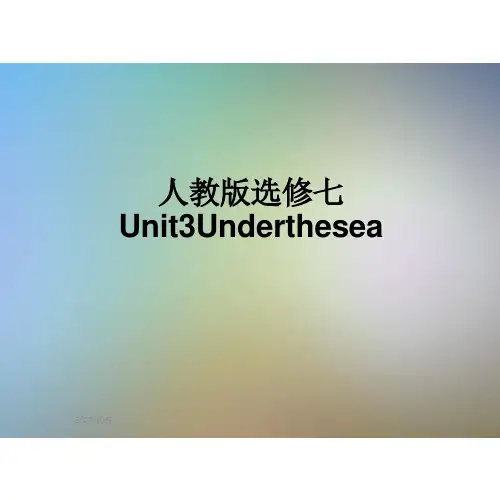
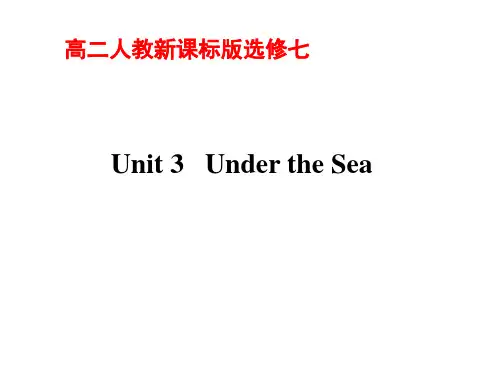

![新人教选修7-Unit3-Under-the-sea-Reading[阅读课件]](https://uimg.taocdn.com/d729124a4531b90d6c85ec3a87c24028915f85de.webp)
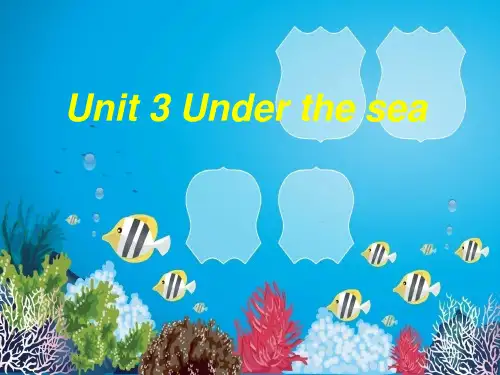
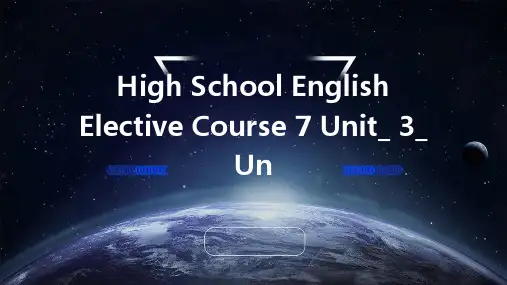
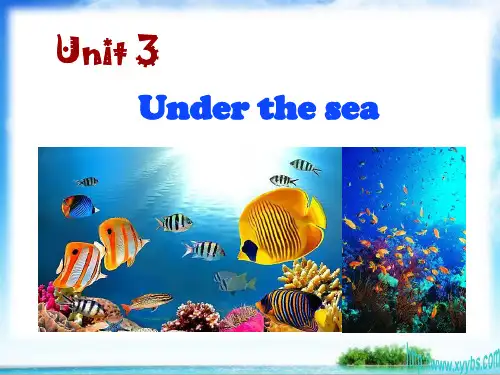
人教版高中英语选修7《Unit 3 Unde r the sea》教案2篇Teaching plan of unit 3 under the sea人教版高中英语选修7《Unit 3 Under the sea》教案2篇前言:英语作为在许多国际组织或者会议上都是必需语言,几乎所有学校选择英语作为其主要或唯一的外语必修课。
英语教学涉及多种专业理论知识,包括语言学、第二语言习得、词汇学、句法学、文体学、语料库理论、认知心理学等内容。
本教案根据英语课程标准的要求和教学对象的特点,将教学诸要素有序安排,确定合适的教学方案的设想和计划、并以启迪发展学生智力为根本目的。
便于学习和使用,本文档下载后内容可按需编辑修改及打印。
本文简要目录如下:【下载该文档后使用Word打开,按住键盘Ctrl键且鼠标单击目录内容即可跳转到对应篇章】1、篇章1:人教版高中英语选修7《Unit 3 Under the sea》教案2、篇章2:人教版高中英语选修7《Unit 3 Under the sea》教案篇章1:人教版高中英语选修7《Unit 3 Under the sea》教案教学准备教学目标1.引导学生通过上下文理解生词的含义:anecdote, annual, witness, accommodation, shore, yell, pack, flee, drag, depth, lip, tongue, abandon, relationship, help out2.帮助学生掌握文中一些描述事物和情景的生动手法,从而体会作者的思想情感,把握文章的精髓。
3 帮助学生通过两个故事,对生活在大洋的虎鲸能有更多的了解,同时对虎鲸给予我们人类忠实的帮助产生由衷的感激,从而加强动物保护和环境保护意识。
教学重难点1.引导学生通过上下文理解生词的含义:anecdote, annual, witness, accommodation, shore, yell, pack, flee, drag, depth, lip, tongue, abandon, relationship, help out2.帮助学生掌握文中一些描述事物和情景的生动手法,从而体会作者的思想情感,把握文章的精髓。
Unit 3 Under the Sea 一、语言要点I单元要点预览词汇部分词语辨析1.shore/seaside/beach/coast/bank2.flee/escape3. deep/deeply词形变化1. depth n. 深, 深度, deeply adv.深深地deep adj.& adv. 深的;深入地,2. conserve v. 保存, 保藏conservation v. 保存, 保持3.vivid adj. 生动的, 鲜明的, 活泼的vividly adv. 生动地, 鲜明地4. awesome adj. 引起敬畏的, 可怕的awe n. 敬畏awe vt.敬畏5.tasty adj. 好吃的, 可口的taste v.品尝;n味道, 味觉tasteless adj. 没味道的, 无鉴赏力的重点单词1.annual adj. 每年的;按年度计算的/ n. 年刊;年鉴2.witness n. 目击者;证人;证据vt. 当场见到;目击3.accommodation n. 住所4.abandon vt. 放弃;遗弃;抛弃5.reflect vt. 映射;反射vi. & vt. 思考6.aware adj. 意识到的;知道的7.scare vt. 恐吓vi. 受惊吓重点词组sort out整理;挑出help out 帮助……(摆脱困难或危难);协助;使……脱离困境throw oneself out of 跃出upside down上下翻转过来重点句型1. It was a time when the killer whale s, or “killers” as they were then called, helped thewhalers catch the baleen whales that were on their annual migration.2. I had already heard that George didn’t like being kept waiting, so even though Ididn’t have the right clothes on, raced after him.3. I’m sitting in the warm night air with a cold drink in my hand and reflecting on theday-a day of pure magic!重点语法被动语态(II)II 词语辨析1). shore/seaside/beach/coast/bank n.海边,海岸【解释】shore 指海岸,湖岸,也指近海的一带。
SectionⅢ—Grammar课后篇巩固提升一、单句填空1.(1)Don’t forget (take)your umbrella when you go out.(2)I will never forget (take)by my parents to visit the Great Wall when I was young.(2)being taken2.(1) (expose)to the strong sunlight,your eyes will be harmed.(2) (ee to realise at an early age the impact of innovation.(2)Being exposed3.(1)After dinner I sit behind the motel by myself, (watch) the sun drop behind the bluffs.(2) (watch) your teacher carefully and you will know how to do the experiment.(2)Watch二、翻译句子1.I heard this song being sung in English then.,我听过有人在用英语唱这首歌。
2.The area is being flooded because of the continuous heavy rain.,那一地区正被洪水围困。
3.他受不了别人那样开他的玩笑。
4.在建的大楼是一座新的购物中心。
5.他的迟到让他的老师非常生气。
6.他成为我们足球队的带队者,这让我们很高兴。
having been made leader of our football team was a pleasure to us.三、阅读理解AIt was a Sunday and the heavy storm had lasted all night.The morning after the storm,though,was beautiful:warm air and a calm,inviting sea touching the shore gently.My father realised it was a good day for fishing and invited my sister and me to go with him.I was only 14 and fishing had never been my thing,but I decided to go all the same.I’m so gla d I did.On the road to the harbour we could see the terrible destruction on the coast,but the harbour itself was in fairly good shape.After all,it was protected by the arms of a bay that had only one tinychannel to the sea.As we got on board,we noticed two big humps(脊背) in the distance.On approaching them,we saw it was a mother whale with her baby.We couldn’t believe it—there aren’t any whales along the coast here.The storm must have driven them across the ocean into the bay,in which the still water was so badly polluted that nothing could survive.The little baby whale—actually as big as our boat—was obviously stuck and could not move.The mother dived under the water and came up suddenly,making big whirlpools(漩涡)and waves.“She’s trying to help her baby,but on the wrong side,” my father said.At this point,my father moved our boat in a semicircle to the other side and,heading the boat towards the baby whale,pushed it gently.With our several gentle pushes the big hump turned over and disappeared under water.Then it swam up right beside its mum.They struggled in their desperate attempts to escape but missed the exit and started heading in the wrong direction.We hurried up to the whales and tried to lead them towards the bay channel.Slowly,theylet us lead them,sometimes rising from the water right beside us to breathe—and to give us a trusting look with those huge eyes.Once they hit their first part of clean water flowing straight from the sea,the mum gave us a wave with her tail and off they swam into the distance.In the excitement it had felt like only a few minutes,but we had been with those wonderful animals for almost an hour and a half.That was the simple and lasting beauty of the day.Nearly four decades later,I still look back fondly to that golden day at sea.1.The author says “I’m so glad I did.” (in Para.2)because .A.he witnessed the whole process of fishingB.he enjoyed the beauty of the calm seaC.he experienced the rescue of the whalesD.he spent the weekend with his family,作者说“我很高兴自己跟父亲一起去钓鱼了”,是因为他有机会经历拯救鲸鱼的过程,对于作者来说这是一段十分美好的回忆。
人教版高中英语选修7《Unit 3 Under thesea》教案人教版高中英语选修7《Unit 3 Under the sea》教案【一】教学准备教学目标1.引导学生通过上下文理解生词的含义:anecdote, annual, witness, accommodation, shore, yell, pack, flee, drag, depth, lip, tongue, abandon, relationship, help out2. 帮助学生掌握文中一些描述事物和情景的生动手法,从而体会作者的思想情感,把握文章的精髓。
3 帮助学生通过两个故事,对生活在大洋的虎鲸能有更多的了解,同时对虎鲸给予我们人类忠实的帮助产生由衷的感激,从而加强动物保护和环境保护意识。
教学重难点1.引导学生通过上下文理解生词的含义:anecdote, annual, witness, accommodation, shore, yell, pack, flee, drag, depth, lip, tongue, abandon, relationship, help out2. 帮助学生掌握文中一些描述事物和情景的生动手法,从而体会作者的思想情感,把握文章的精髓。
3 帮助学生通过两个故事,对生活在大洋的虎鲸能有更多的了解,同时对虎鲸给予我们人类忠实的帮助产生由衷的感激,从而加强动物保护和环境保护意识。
教学过程Step1 Lead –in Warming-up(5mins) 问题导入教师呈现问题和图片T: Have you seen plants andanimals that live under the sea? Where did you see them? Whats this? Yes,theyre killer whales. How much do you know about them? Ill show you a shortvideo.【意图说明】在读前这个环节,通过几个问题,激发学生原有的对海洋生物的知识储备,再展示一些相关的图片,认识一些常见海底动物的英文名称。